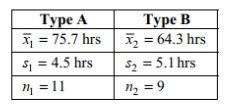Construct the indicated confidence interval for the difference between the two population means. Assume that the two samples are independent simple random samples selected from normally distributed populations. Do not assume that the population standard deviations are equal. A paint manufacturer wished to compare the drying times of two different types of paint. Independent simple random samples of 11 cans of type A and 9 cans of type B were selected and applied to similar surfaces. The drying times, in hours, were recorded. The summary statistics are as follows.
Construct a 98% confidence interval for the difference between the mean drying time for paint of type A and the mean drying time for paint of type B.
Definitions:
Organizations
Entities comprised of multiple people working together towards common goals or objectives, structured in a way that facilitates coordination and achievement.
Idea Generation
The process of creating, developing, and communicating new concepts or solutions.
Innovation Process
A systematic approach that involves the generation, development, and implementation of new ideas, products, or services to create value or solve a problem.
Problem-Solving
The process of identifying a problem, generating possible solutions, and implementing a solution to address the issue.
Q7: The following frequency distribution analyzes the
Q21: Which of the following statements is not
Q22: Assume that a simple random sample has
Q30: Explain how a nonstandard normal distribution differs
Q31: A multiple choice question has 18 possible
Q35: <span class="ql-formula" data-value="( - 4 x -
Q37: Helene claimed that the expected value when
Q37: Test the given claim about the
Q51: An engineer is designing a machine
Q152: At the start of a chemistry experiment,